-
Contact Information
For General Enquiries:
For Abstract Enquiries:
Abstracts Topics & Submission Information
View E-Poster Listing View Oral Presentation Listing
Notes for Oral, Poster and Symposium presenters
All Oral, Poster and Symposium presenters are requested to register online and make full payment by 14 October 2020. Please indicate that you are a presenter and state your abstract submission identifier numbers (for Oral and Poster presenters) during your registration. After you have successfully registered, we will send you the guidelines and templates for your presentation.
For more information, please contact .
Submissions are now closed
Abstracts received after the deadline will not be accepted and will therefore not be considered for the programme or for publication.
Your e-poster for 24th World Congress of the IACAPAP will be made available to all attendees in the E- library of the virtual event platform. Participants will be able to access all e-posters at any time during the congress (3 full days) and until 4 March 2021 on-demand.
- E-Poster: Prepare your poster in a digital format (e-poster)
- File format: PDF
- Structure: The e-Poster should be of 1 page in portrait (vertical) orientation. Please use the IACAPAP official e-poster template as attached.
- Media: Images/photos, graphs, hyperlinks, and tables can be included in the e-poster. However, animated images and animations are not permitted for e-Posters and will be non-functioning.
- File Size: Maximum file size is 4 Megabytes (4MB)
- Display: Indicate your abstract submission identifier number in the upper left corner of the e-poster.
- File name: Ensure that you save your file with the following name: last name_ abstract submission identifier number. For example: Kingston_ IACAPAP20-ABS_P-1119
- Content: Do not overload your e-poster. Seek simplicity, keep text to a minimum and avoid redundancies
- Note: Do not use any passwords or encryption for your presentation.
Should you have any further queries relating to your presentation, please do not hesitate to contact a member of our team for assistance via one of the following method(s):
24th World Congress of the IACAPAP Secretariat
Your oral presentation for 24th World Congress of the IACAPAP will be made available to all attendees in the E- library of the virtual event platform. Participants will be able to access all e-posters at any time during the congress (3 full days) and until 4 March 2021 on-demand.
Self-recording via ZOOM
Your self-recorded presentation video should not exceed 15 minutes.
IMPORTANT NOTE: All pre-recorded oral presentations must adhere to the 15-minute presentation length. If your presentation goes over time, it will be sent back to you to correct and re-upload.
Please follow the instructions as per below to record your oral presentation via a free ZOOM account.
-
Install the Zoom.us software or application on your computer or device from http://zoom.us/download. Once the application has installed, click Sign In (for existing account users) or Sign up free to create an account.

- From the main Zoom window, click Meetings in the top navigation menu.
-
In your Personal Meeting window, click Start.
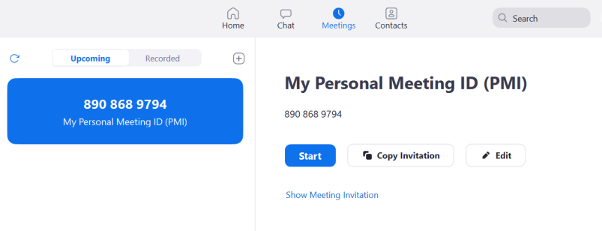
-
Join Audio by either using a microphone or headset through your computer.
Click on “Join with Computer Audio” to proceed. You may wish to do a sound testing By clicking “Test Speaker and Microphone”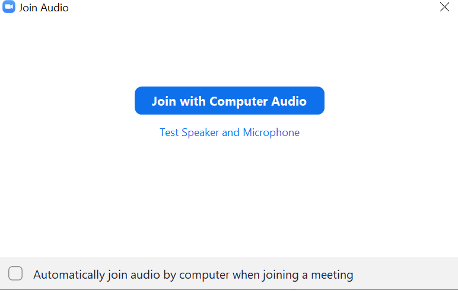
-
With the Zoom meeting window open, hover your mouse over the bottom of the window. You should see the menu bar below
-
Click the Start Video button to capture yourself on video while speaking.
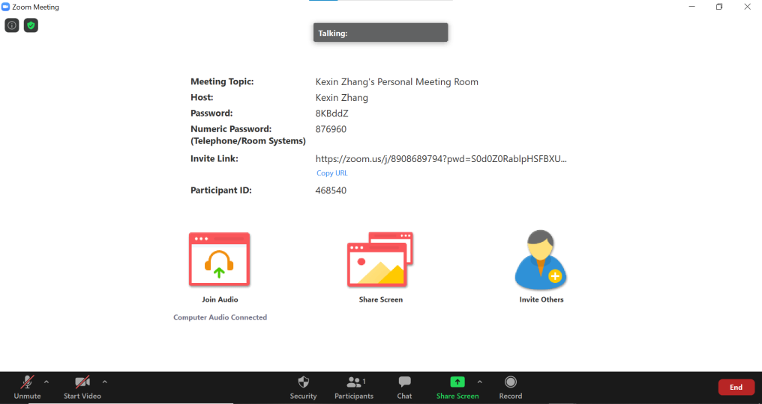
Note: We strongly encourage you to use the Official IACAPAP Virtual Background Image during your recording. Kindly refer to the instructions on how to enable the Virtual Background as per below.-
Click on the small sign ^ beside the button “Start Video”, next click on the “Choose Virtual Background”.
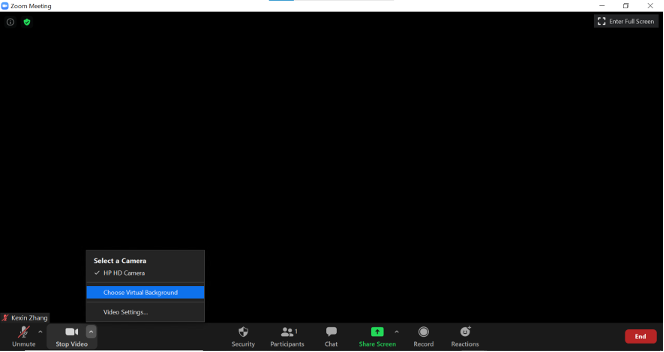
- Click on “Add Image” to select the IACAPAP virtual background by clicking + and upload to ZOOM. *Remember to save the virtual background on your computer desktop.
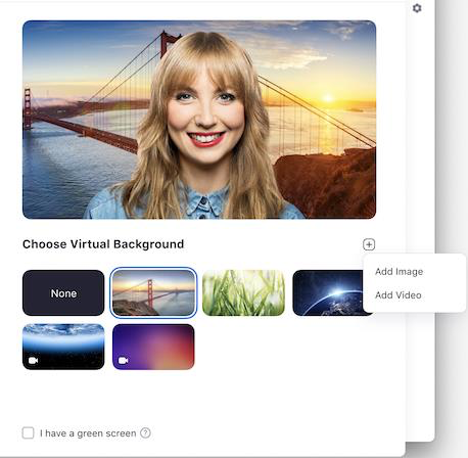
-
- Before you start your recording, select “Share Screen” and start sharing the screen with your presentation. Once you start sharing your screen, the menu will move to the top of your screen. You need to open your presentation in “Slide Show” mode (full screen) before sharing your screen.

-
After you have completed the previous steps and you are ready to record your presentation, click on “More” button then select the “Record” button to start your audio and video recording. A red dot sign
 will appear once you start the recording.
will appear once you start the recording.
-
You can pause or stop your recording at any point during the presentation.
- After you are done with your oral presentation and you want to end the meeting and save the video, click on “End” meeting. It will stop the recording and your recorded presentation will be saved automatically.
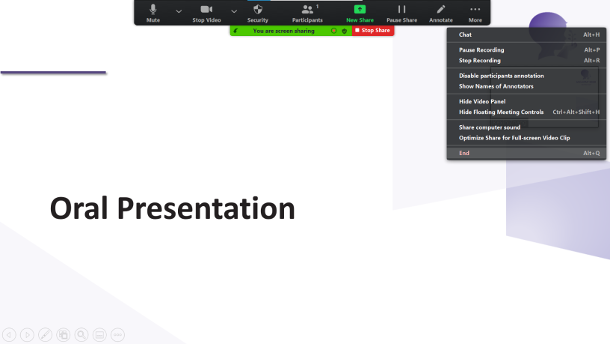
- At the top of the Zoom window,to see your recordings, click on the tab labelled “Recorded”
- After you select the presentation you want to view, click “Open”

- This will open the folder where the recording is saved.
By default, the recordings are saved in your Documents folder in a sub-folder called Zoom - Please rename the “Zoom” file (MP4 format) with the following name: first name and last name_ abstract submission identifier number. For example: Kingston Ng_O-1119

Troubleshooting Common Issues in Zoom:
- Audio Issues: Before starting your presentation, test the audio by selecting Test Speaker and Microphone, and follow the instructions on the screen.
- Video Issues: Make sure your camera is turned on, plugged in, and selected in Zoom by choosing the video icon. If it is not, use the drop down to select the correct camera. If the camera is turned on, make sure nothing is blocking the camera view. If using an external web camera, try connecting it to a different USB port and repeat the steps.
Best Practices and Tips
Prior to your presentation
- Restart your computer / laptop to optimize your RAM – allowing you to optimize your device’s
- performance when the recording is ongoing.
- After restarting, turn off all unnecessary applications that boot upon restart
- Turn off all applications with in-built notifications (such as WhatsApp Web, Microsoft Outlook /
- Teams, etc.) to avoid unnecessary interruptions
- Do a test of your audio and video capture devices to ensure that they are in working condition
- without any input issues
- Run a direct Internet connection via LAN cable to your laptop/computer
- If a LAN cable is not available, a dedicated Wi-Fi network is advised with all web-intensive
- programs (e.g. video streaming sites) turned off.
- Utilize a standalone webcam with HD recording capabilities
- Utilize a standalone microphone or headset with an in-built microphone
Selecting the best spot for your presentation:
- Ensure that you are in a quiet and well-lit room, but avoid sitting too near or with your back
- against a window to prevent overexposure
- Sit against a simple setting (e.g. plain wall / clutter-free background) to minimize distractions –
- keep the focus on you and not your surroundings
- Position your camera far enough to capture your shoulder and entire face, with some space
- around as buffer
- Align your camera in line with your eyes, so that you are looking straight at the camera – use
- items to prop up your device or lower your seat
Tips to dress right for the camera:
- Wear a conservative outfit that does not draw attention away from your face
- Choose a solid coloured top or blazer, and avoid fabrics with bright colours or distracting patterns as this may cause your video feed to flicker.
- Ensure that your clothes contrast with your background colors
- Avoid wearing any reflective jewellery or accessories
During your presentation:
- Present naturally, complete with expressions and gestures as required – avoid looking stiff on camera
- Observe good posture by sitting upright – sit on the front half of your seat, with your feet firmly on the ground to maintain this posture
- Avoid speaking too quickly and without pause – your audience needs time to follow and process what you have said
- If possible, place your microphone below your lips to improve resonance and reduce echoes picked up
- Project your voice when speaking to avoid muffled speech
- Avoid typing or shuffling papers during the presentation, as it can be picked up very easily by the audience
Should you have any further queries relating to your presentation, please do not hesitate to contact a member of our team for assistance via one of the following methods:
24th World Congress of the IACAPAP Secretariat











































